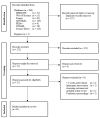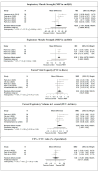Effects of Respiratory Muscle Training on Functional Ability, Pain-Related Outcomes, and Respiratory Function in Individuals with Low Back Pain: Systematic Review and Meta-Analysis
- PMID: 38892764
- PMCID: PMC11172635
- DOI: 10.3390/jcm13113053
Effects of Respiratory Muscle Training on Functional Ability, Pain-Related Outcomes, and Respiratory Function in Individuals with Low Back Pain: Systematic Review and Meta-Analysis
Abstract
Objectives: The aim of this meta-analysis was to determine the effects of respiratory muscle training (RMT) on functional ability, pain-related outcomes, and respiratory function in individuals with sub-acute and chronic low back pain (LBP). Methods: The study selection was as follows: (participants) adult individuals with >4 weeks of LBP; (intervention) RMT; (comparison) any comparison RMT (inspiratory or expiratory or mixed) versus control; (outcomes) postural control, lumbar disability, pain-related outcomes, pain-related fear-avoidance beliefs, respiratory muscle function, and pulmonary function; and (study design) randomized controlled trials. Results: 11 studies were included in the meta-analysis showing that RMT produces a statistically significant increase in postural control (mean difference (MD) = 21.71 [12.22; 31.21]; decrease in lumbar disability (standardized mean difference (SMD) = 0.55 [0.001; 1.09]); decrease in lumbar pain intensity (SMD = 0.77 [0.15; 1.38]; increase in expiratory muscle strength (MD = 8.05 [5.34; 10.76]); and increase in forced vital capacity (FVC) (MD = 0.30 [0.03; 0.58]) compared with a control group. However, RMT does not produce an increase in inspiratory muscle strength (MD = 18.36 [-1.61; 38.34]) and in forced expiratory volume at the first second (FEV1) (MD = 0.36 [-0.02; 0.75]; and in the FEV1/FVC ratio (MD = 1.55 [-5.87; 8.96]) compared with the control group. Conclusions: RMT could improve expiratory muscle strength and FVC, with a moderate quality of evidence, whereas a low quality of evidence suggests that RMT could improve postural control, lumbar disability, and pain intensity in individuals with sub-acute and chronic LBP. However, more studies of high methodological quality are needed to strengthen the results of this meta-analysis.
Keywords: disability; low back pain; pain threshold; postural balance; respiratory function tests; respiratory muscle training.
Conflict of interest statement
The authors declare no conflicts of interest.
Figures




Similar articles
-
Respiratory muscle training in children and adults with neuromuscular disease.Cochrane Database Syst Rev. 2019 Sep 5;9(9):CD011711. doi: 10.1002/14651858.CD011711.pub2. Cochrane Database Syst Rev. 2019. PMID: 31487757 Free PMC article.
-
A combined inspiratory and expiratory muscle training program improves respiratory muscle strength and fatigue in multiple sclerosis.Arch Phys Med Rehabil. 2013 Oct;94(10):1964-70. doi: 10.1016/j.apmr.2013.05.005. Epub 2013 May 25. Arch Phys Med Rehabil. 2013. PMID: 23714277 Clinical Trial.
-
Effect of respiratory muscle training in patients with stable chronic obstructive pulmonary disease: A systematic review and meta-analysis.Heliyon. 2024 Mar 27;10(7):e28733. doi: 10.1016/j.heliyon.2024.e28733. eCollection 2024 Apr 15. Heliyon. 2024. PMID: 38576558 Free PMC article.
-
The effects of respiratory muscle training on respiratory function and functional capacity in patients with early stroke: a meta-analysis.Eur Rev Aging Phys Act. 2024 Feb 22;21(1):4. doi: 10.1186/s11556-024-00338-7. Eur Rev Aging Phys Act. 2024. PMID: 38383309 Free PMC article. Review.
-
Effects of respiratory muscle training on post-stroke rehabilitation: A systematic review and meta-analysis.World J Clin Cases. 2024 Jul 16;12(20):4289-4300. doi: 10.12998/wjcc.v12.i20.4289. World J Clin Cases. 2024. PMID: 39015926 Free PMC article.
Cited by
-
Exploratory Ultrasound Analysis of the Diaphragm and Respiratory Capacity in Women with Primary Dysmenorrhea: A Cross-Sectional Observational Study.Methods Protoc. 2025 Feb 4;8(1):15. doi: 10.3390/mps8010015. Methods Protoc. 2025. PMID: 39997639 Free PMC article.
References
-
- Fujii R., Imai R., Shigetoh H., Tanaka S., Morioka S. Task-specific fear influences abnormal trunk motor coordination in workers with chronic low back pain: A relative phase angle analysis of object-lifting. BMC Musculoskelet. Disord. 2022;23:161. doi: 10.1186/s12891-022-05118-x. - DOI - PMC - PubMed
-
- Osumi M., Sumitani M., Otake Y., Nishigami T., Mibu A., Nishi Y., Imai R., Sato G., Nagakura Y., Morioka S. Kinesiophobia modulates lumbar movements in people with chronic low back pain: A kinematic analysis of lumbar bending and returning movement. Eur. Spine J. 2019;28:1572–1578. doi: 10.1007/s00586-019-06010-4. - DOI - PubMed
Publication types
LinkOut - more resources
Full Text Sources
Miscellaneous

